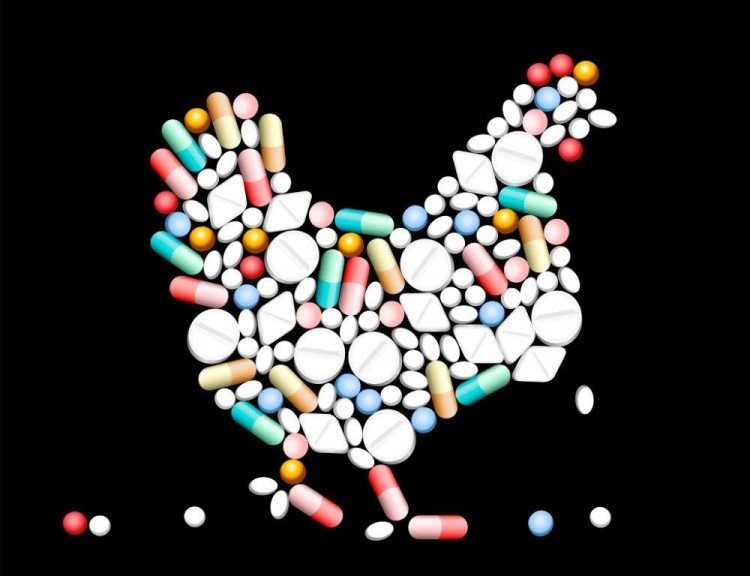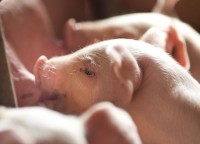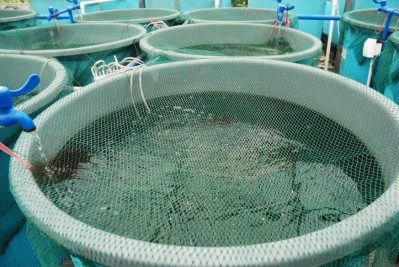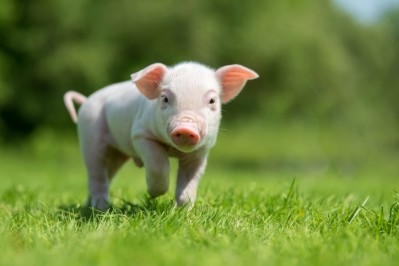Resistant starch can play a big role in pig and poultry gut health: review

“RS has the potential to improve gut health and function by modifying and stabilizing gut microbial community and by improving the immunological status of the host,” wrote Alemu Regassa and Charles Martin Nyachoti, researchers based at the Department of Animal Science at the University of Manitoba, Canada.
RS is a type of starch that resists enzymatic digestion in the upper parts of the gastrointestinal tract and therefore passes to hind gut where it can be fermented by resident microorganisms, they said.
Microbial fermentation of RS in the hind gut results in the production of short chain fatty acids (SCFA). Acetate, propionate, and butyrate the major SCFA produced in the colon, of which butyrate is thought to be most beneficial for gut health, they added.
“Production of SCFA in turn results in growth and proliferation of colonic and cecal cells, increased expression of genes involved in gut development, and creation of an acidic environment. The acidic environment suppresses the growth of pathogenic microorganisms while selectively promoting the growth of beneficial microbes.”
However, their review noted that growth may be compromised when RS is supplemented in pig or poultry feed for a long time or in a large amount as energy production from SCFA is assumed to be less efficient than that of glucose.
“Therefore, determination of the ideal length of supplementation and the amount of supplemental RS may help to reduce growth depression and increase the use of RS as one of the alternatives for in-feed antibiotics.”
Thee are four different types of RS: Resistant starch type 1 is a starch that is found in grains, seeds and legumes and RS2 is the one found in some starchy foods, including raw potatoes and green bananas. Resistant starch 3 is formed when certain starchy foods, including potatoes and rice, are cooked and then cooled. Resistant starch type 4 is the starch formed through a chemical process.
Background
Regassa and Nyachoti explained their review “was conducted to summarize the current state of knowledge on the use of RS to improve gut health and provide practical recommendations to further investigate the suitability of RS as one of the alternatives to in-feed antibiotics.”
In any test of the suitability of a feed additive as an alternative to in-feed antibiotics, they said its efficacy must be compared with antibiotics in terms of boosting gut health and function.
However, so far, very few studies have examined the effect of RS on gut health and function in comparison with in-feed antibiotics (Leeson et al., 2005; M’Sadeq et al., 2015), they noted.
While there have been several studies examining the effect of different types of RS on gut health and function, with most of them reporting a positive response from RS supplementation, results from a few studies were inconsistent, said the Canadian reviewers.
RS and gut health
The authors noted a study whereby supplementation of a corn-soybean meal-wheat-wheat middlings-based control diet with raw potato starch (RPS) at 0.5% or 1.0% daily for 28 days was reported to improve fecal consistency and total cecal SCFA concentrations and reduce ileal and cecal digesta pH in pigs weighing 7.2 kg (Heo et al., 2014).
That work showed the supplementation of RPS did not reduce the growth performance of piglets, showing RPS “has the potential to enhance the characteristics of a functional gut in weaned pigs without adverse effects on growth.”
They referenced another piece of research on the effect of RPS with or without probiotics on SCFA concentrations and fecal consistency and growth performance has been examined (Krause et al., 2010).
The results of that study, they said, indicated increased colonic digesta SCFA concentrations and fecal consistency in pigs fed diets containing 14% RPS compared with pigs fed non-RPS diets. Although average daily gain was improved in pigs fed a diet containing a combination of RPS and probiotics, it was reduced by supplementation of RPS alone, which the Canadian reviewers said could be attributed to reduced average daily feed intake (FI) in this group.
“This shows that although gut health can be improved by supplementation of RPS, growth may be impaired by the low FI, which can be explained by satiety inducing effect of RS (Sajilata et al., 2006a; Sajilata et al., 2006b; Da Silva et al., 2012.). Therefore, developing a phase-wise feeding strategy where piglets can be supplemented with known amount of RS shortly after weaning might help to reduce the negative effect on growth.”
The reviewers noted that immediate post-weaning period is a critical time for the survival of piglets. "Newly weaned pigs depend on passive immunity from sow’s milk. Piglets do not have access to the passive immunity from mothers’ milk after weaning. Piglets are exposed to pathogenic challenges and unfortunately their gastrointestinal barrier function is not well developed at this time. Hence, this period is characterised by post-weaning growth lag causing tremendous economic losses to the swine industry." Additionally, major qualitative and quantitative changes in the gastrointestinal microbiota of pigs take place at this time.
Similarly, they said newly hatched chicks are confronted with stressful situations such as long distance shipping, enteric infections and respiratory diseases that are responsible for growth depression or death.
Gut structure
The reviewers cited a study where the effect of RPS originating from two types of potato (Tuberosum and S. Phureja) on histomorphology was examined - Ariza-Nieto et al., (2012) saw birds fed RPS had higher duodenal and jejunal villus to crypt ratio compared to birds fed a control diet without RS, showing “the potential of RS to improve gut structure”.
Although the health benefit of RS1, 2, and 3 have been extensively investigated (Birt et al., 2013; Singh et al., 2010), chemically modified RS - RS4 - is also gaining attention because of the possibility to control reduction in starch digestibility by targeted modification of the starch molecule, continued the Canadian team.
Bacterial species favored due to RS feeding could also depend on RS type, they said.
They reported a study from Martinez et al., (2010), which showed RS2 increased the fecal abundance of important butyrate producing Ruminococcus bromii and reduces the abundance of Eubacterium rectale, whereas RS4 increased Bifidobacterium adolescentis and Parabacteroides distasonis.
“In a comprehensive microbial characterization of cecal samples obtained from growing pigs fed diets containing RS4, the relative abundance of Ruminococcus, Parasutterella, Bilophila, Enterococcus, and Lactobacillus were reduced, whereas the abundance of Meniscus and Actinobacillus was increased ( Metzler-Zebelia et al., 2015), showing the potential effect of the chemical structure of RS on the relative abundance of microbial species.”
Haenen et al., (2013) looked at the effects of a diet on luminal microbiota composition, luminal SCFA concentrations, and the expression of host genes involved in SCFA uptake and signaling, as well as satiety regulation in mucosal tissues of small intestine, cecum, and colon.
The reviewers said those researchers saw healthy gut-associated butyrate-producing Faecalibacterium prausnitzii, but reduced relative abundance of potentially pathogenic members of the Gammaproteobacteria in pigs fed diets containing high RS.
The reviewers also cited work showing RS increases the expression of intestinal genes that play an important role in gut health:
“Analysis of the colonic transcriptome profiles in pigs revealed that RPS diets changed the colonic expression profile of genes that are involved in immune response and significantly increased the expression of one of the pro-inflammatory cytokine, IL-1β, but suppressed the expression of genes involved in lysosome (Sun et al., 2015).”
This finding, they said, suggests long-term intake of a high amount of RS may have both positive and negative effects on animal gut health.
RS and growth performance
The authors saw that depending on the source and the amount of RS in the diet, FI and feed efficiency, and growth performance in pigs may be variable.
“For example, Li et al. (2007) reported FI and feed efficiency and subsequently growth performance in barrows fed a diet containing 50% high amylose maize starch (RS2) were decreased compared with control pigs fed corn and digestible corn starch.
“However, they noted that growth performance measurements were nearly similar between growing pigs fed a diet containing 250 g/kg of corn starch and 250 g/kg of RPS (Nofrarías et al., 2007).”
Pluske et al. (1998) reported that daily intake of about 280 g of RS did not significantly reduce average daily gain and live weight at slaughter compared to other treatments in growing pigs. The reviewers said these data were consistent with those of Doti et al. (2014) who reported similar growth performance traits and carcass characteristics in gilts fed diets containing 184 to 363 g/kg RS from cereal and legume grains.
“Whether the inconsistencies among the results from different studies could be attributed to differences in the amount of RS or the age of the animal needs further investigation.”
Source: Animal Nutrition
DOI: https://doi.org/10.1016/j.aninu.2018.04.001
Title: Application of resistant starch in swine and poultry diets with particular reference to gut health and function
Authors: A. Regassa, C. M. Nyachoti

















